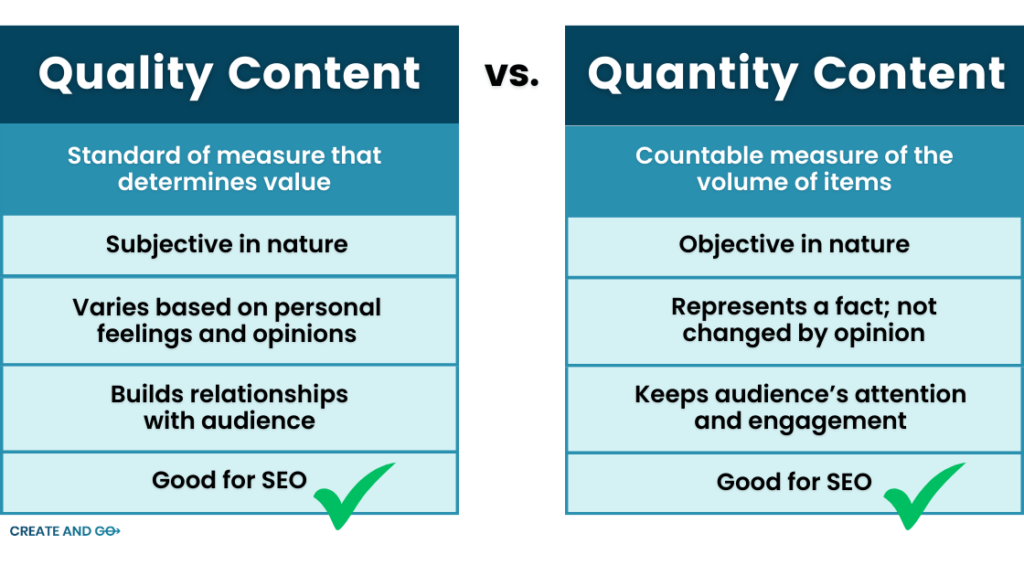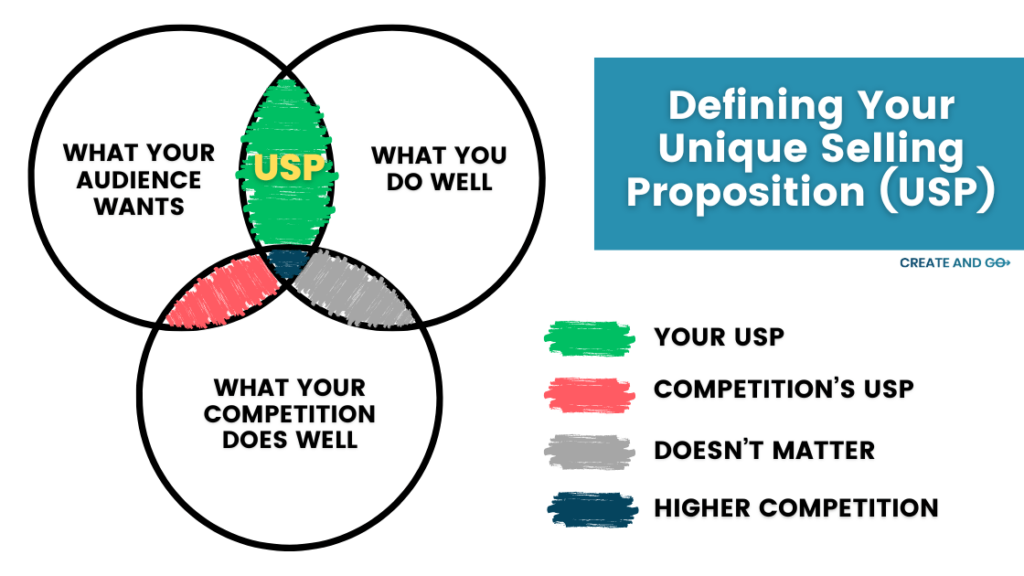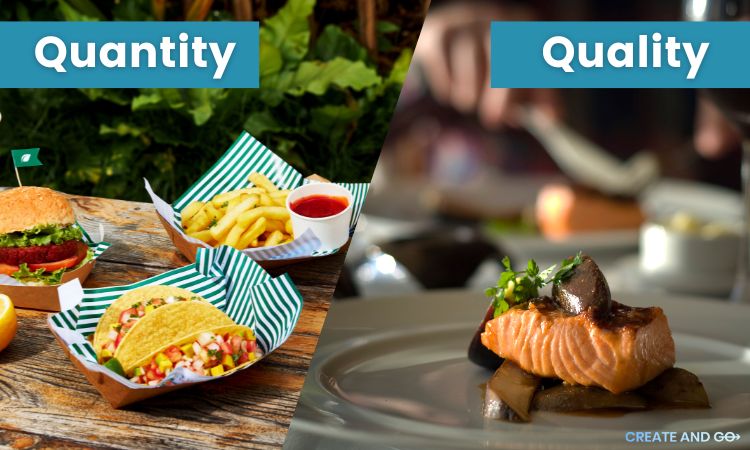In the ever-evolving landscape of content creation, one of the most perennial debates revolves around the age-old question: quality or quantity?
Quality and quantity are both features of something, but they differ in that quality is subjective and quantity is objective.
As aspiring bloggers and content creators, we often find ourselves grappling with this dilemma.
Should we focus on producing a high volume of content to increase our visibility, or should we prioritize crafting meticulously curated pieces that showcase our expertise and creativity?
Understanding the difference between quality vs. quantity is key to evaluating your content strategy and the impact that your content has on your audience.
In this blog post, we’ll delve deep into the realms of quality vs. quantity, exploring their differences and examining their respective impacts on success in the realm of blogging and content creation.
What is the Difference Between Quantity and Quality?

Quality is a measure of excellence and a special characteristic of something. It can refer to how something is made or how it compares to others.
Quality is subjective in nature and can vary based on personal feelings and opinions.
For example, “Those shoes are magnificent.” and “These automobiles seem luxurious.” are statements that describe the quality of something.
Quantity, on the other hand, is the extent, size, or sum of something. It is countable or measurable and can be expressed as a numerical value.
Quantity is objective in nature and represents a fact that is not swayed or influenced by personal feelings and sentiments.
For example, “How much is this handbag?” and “It costs $70,000 to accommodate this community.” are examples referring to the specific quantity of something.
In business, quality is a standard of measurement that determines the value of an item compared to similar items. In reference to output, it often refers to creative work, effort, support, and value.
The quality is dependent on the user.
Quantity is a countable measure of items and does not vary based on the perspective of the user.’
Understanding Quality Content
Quality content is the cornerstone of any successful blog or content platform. But what exactly constitutes quality content?
At its essence, quality content is valuable, relevant, and engaging. It provides readers with actionable insights, valuable information, or meaningful conversations that resonate with their interests and needs.
Quality content generally requires more thought and skill than quantity content.
Key Characteristics of Quality Content
- Relevance: Quality content is tailored to the interests and needs of the target audience. It addresses their pain points, answers their questions, or provides solutions to their problems.
- Accuracy: All content should be well-researched and factually accurate, but quality content relies on credible sources and provides readers with reliable information that they can trust.
- Engagement: It captivates and engages your audience. It sparks conversation, elicits emotions, or encourages interaction through comments, shares, or likes.
- Originality: Quality content is original and unique. It offers a fresh perspective, presents new ideas, or delivers insights that haven’t been explored before.
- Value: Finally, and most importantly, it delivers value to the reader. Whether it’s educational, entertaining, or inspirational, it leaves a lasting impression and enriches the reader’s experience.
The Importance of Quality Content
Quality content plays a pivotal role in building credibility, establishing authority, and fostering trust with your audience. When you consistently deliver high-quality content, you position yourself as a trusted source of information in your niche, attracting loyal followers and potential customers.
Quality content is also more likely to be shared, linked to, and referenced by other bloggers and influencers within your industry.
This not only amplifies your reach but also enhances your SEO efforts, driving organic traffic to your blog or website.
Creating valuable content lays the foundation for long-term success in the world of blogging and content creation. It cultivates a loyal audience, enhances your reputation, and sets you apart as a leader in your field.
Finding Your Unique Value Proposition
One way to deliver more value to your particular audience is to identify and leverage your unique value proposition (UVP).
Your UVP encompasses what sets you apart from competitors and why your audience should choose to consume your content over others.

Defining your UVP starts with understanding your audience’s needs, preferences, and pain points.
- What problems are they trying to solve?
- What questions are they seeking answers to?
By conducting thorough audience research and listening to feedback, you can gain valuable insights into how to tailor your content to meet their needs effectively.
Once you’ve identified your audience’s needs, the next step is to articulate how your content uniquely addresses those needs. This could involve leveraging your expertise in a particular niche, offering a fresh perspective on established topics, or providing unique insights or experiences that resonate with your audience.
Your UVP should permeate every aspect of your content strategy, from the topics you choose to cover to the tone and style of your writing. By consistently delivering content that aligns with your UVP, you can build a loyal audience that recognizes and values what you uniquely bring to the table.
Understanding Quantity Content
On the other end of the spectrum lies quantity content. Quantity content prioritizes volume over depth, aiming to churn out a high volume of content in a short period of time.
While it probably seems apparent that quality content always wins, this actually isn’t always the case. Quantity matters too.
While quantity content may lack the polish and refinement of quality content, its proponents argue that the sheer volume of output can yield significant benefits in terms of visibility and exposure.
Key Characteristics of Quantity Content
- Frequency: Quantity content is most often characterized by its high frequency of production. Bloggers and content creators often adhere to strict publishing schedules, releasing new content on a daily or weekly basis.
- Breadth: Because of the high quantity, your content will generally cover a wider range of topics and subjects. It may sacrifice depth and specificity in favor of breadth, catering to a diverse audience with varying interests and preferences.
- Efficiency: Quantity content emphasizes efficiency and speed. Writers may prioritize numbers over perfection, opting for quick turnaround times and streamlined production processes.
- Consistency: Quantity content relies on consistency to maintain momentum and engagement. Bloggers may sacrifice occasional dips in quality in favor of maintaining a steady stream of content to keep their audience engaged.
The Impact of Quantity Content
While quantity content may lack the refinement and depth of its quality counterpart, it can still yield significant benefits for bloggers and content creators. By producing a vast quantity of content, you increase your visibility and reach on various platforms, ensuring that your brand remains top of mind for your audience.
Quantity content also plays a crucial role in search engine optimization (SEO) efforts. Search engines favor websites that regularly update their content, indexing new pages and boosting their rankings in search results.
By consistently publishing new content, you can improve your chances of appearing higher in search engine results pages (SERPs) and driving organic traffic to your website.
Writing content more often can also help you capitalize on trending topics within your niche. By staying agile and responsive to current events and industry trends, you can position yourself as a relevant and authoritative voice within your field.
What Content is More Important for SEO?
Understanding how quality and quantity content impact SEO is essential for content creators trying to play nice with the algorithms and rank in search engine results.
Quality content is inherently aligned with the principles of SEO, as search engines prioritize content that provides value, relevance, and a positive user experience.
Additionally, quality content:
- Attracts backlinks from authoritative websites, which are crucial for improving a website’s domain authority and credibility in the eyes of search engines.
- Is also more likely to be shared on social media platforms, which can also influence SEO rankings when users engage with the content.
- Tends to have longer dwell times and lower bounce rates, indicating that users find the content engaging and relevant to their search queries.
Search engines like Google take these user engagement metrics into account when determining the relevance and authority of a webpage, which can positively impact its ranking in search results.

Now, while quantity content may not always meet the same standards of quality as its counterpart, it can still have a significant impact on SEO.
Quantity content:
- Leads to higher volumes of indexed pages that usually target a wider range of long-tail keywords.
- Can signal to search engines that a website is active, authoritative, and regularly updated, which can positively influence its ranking in SERPs.
- Allows content creators to target a diverse range of keywords and topics, increasing the likelihood of capturing organic traffic from a variety of search queries.
However, it’s essential to note that simply producing a large quantity of low-quality content is unlikely to yield sustainable SEO results in the long run.
Search engines are becoming increasingly sophisticated at detecting and penalizing content that is thin, duplicate, or lacking in value.
The key to achieving SEO success lies in finding the right balance between quality and quantity content.
Balancing Quality vs. Quantity
While quality and quantity may seem like opposing forces, the reality is that they can (and should) coexist harmoniously in your content strategy.

Ideally, you should prioritize high-quality content that meets the needs and interests of your target audience while also maintaining a consistent publishing schedule to signal to search engines that your website is active and authoritative.
Striking the right balance will help you can maximize their organic visibility, attract relevant traffic, and ultimately drive conversions and engagement on their website.
In the ever-evolving landscape of SEO, quality and quantity content will continue to play complementary roles in helping websites achieve their search engine optimization goals.
Key Tips to Find the Optimal Balance
Striking the right balance between these two types of content is key to achieving long-term success in the world of blogging and content creation.
Set Realistic Goals
Define your objectives and establish realistic goals for your content strategy.
Determine whether your primary focus is on building authority and credibility through quality content or increasing visibility and reach through quantity content.
It’s also okay to focus on both of those things, but make sure not to overreach and to uphold your commitment to your publishing schedule.
Prioritize Your Audience
Always keep your audience’s needs and preferences top of mind. Tailor your content strategy to address their interests, pain points, and aspirations, whether that means delivering in-depth guides and tutorials or producing bite-sized, snackable content.
Your audience will always appreciate quality content, but not if they have to wait 3 months for it.
Remember to find a balance between both types of content not just for SEO purposes but also to keep your audience engaged.
Focus on Evergreen Content
Invest in creating evergreen content that provides long-term value to your audience.
While timely and trending topics have their place, evergreen content stands the test of time, continuing to attract traffic and engagement months or even years after its publication.
Batch Your Content Creation
Streamline your content production process by batching similar tasks together.
Dedicate specific blocks of time to research, writing, editing, and promotion, allowing you to work more efficiently and consistently produce high-quality content.
Batching your keyword research and topic generation is a great place to start.
Iterate and Improve
Continuously monitor and evaluate the performance of your content to identify areas for improvement.
Pay attention to metrics such as engagement, traffic, and conversion rates, and use this data to refine your content strategy over time.
FAQs About Quantity vs. Quality
Defining Your Content Strategy
In the ongoing debate between quality and quantity, the answer lies not in choosing one over the other but in striking the right balance between the two.
Quality content forms the bedrock of your brand, establishing credibility, authority, and trust with your audience. Quantity content, meanwhile, enhances your visibility and reach, ensuring that your brand remains top of mind for your audience.
By finding the optimal balance between quality and quantity, you can create a content strategy that delivers value, engages your audience, and drives success in the competitive world of blogging and content creation.
So whether you’re prioritizing depth and refinement or embracing speed and volume, remember that the key to success lies in delivering content that resonates with your audience and leaves a lasting impression.